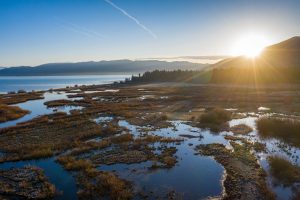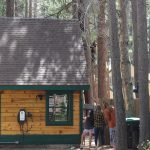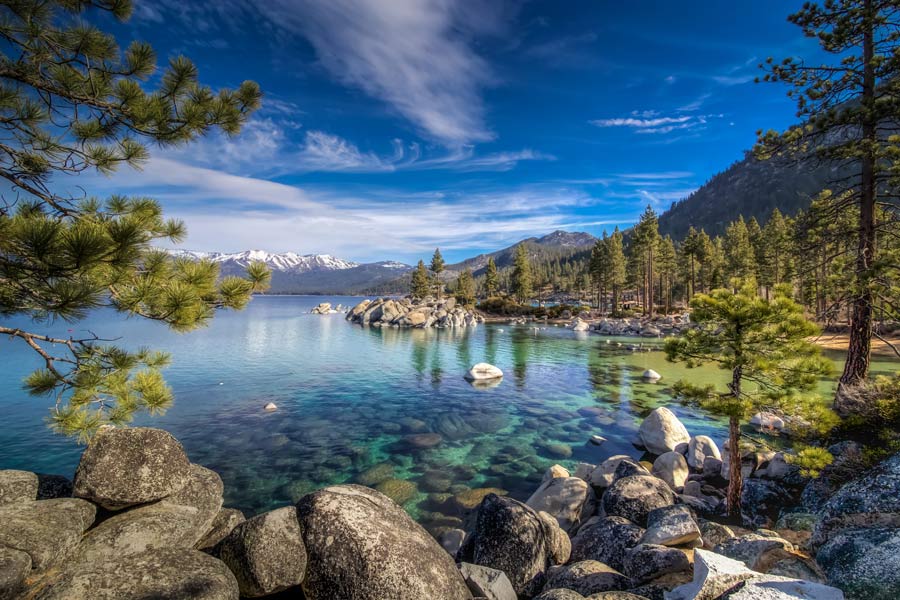Mount Tallac: Emblem of mystique, risk
A year ago this week a 20-year-old UC Santa Cruz student slid 600 feet to his death after losing control while glissading down Mount Tallac.
The death of Ian Carney highlighted the increasing number of people traveling into Tahoe’s winter backcountry and the risk they take for adventure’s sake.
Six days after Carney’s death, another skier experienced a close call, falling face first for several feet, hitting his head and losing consciousness. He eventually used his cell phone to contact rescuers. Six years ago, a cross country skier also fell to his death on Mount Tallac.
The 9,735-foot mountain is a landmark at South Shore and beckons to backcountry enthusiasts with its open faces and majestic features. A cross-shaped depression known by the foreboding moniker “The Cross” is a popular jaunt for expert skiers and snowboarders.
Three large bowls, facing north, southeast and west are notably absent of trees, a sign of former avalanche activity.
“Tallac is not the most advanced mountain, but certainly for around Lake Tahoe, it’s serious enough,” said Kirkwood ski patrol supervisor Todd Rudhall.
Slip and fall
Rudhall said the mountain not only provides opportunity for significant avalanche danger, but also the possibility for slipping and falling on icy slopes, the cause Carney’s death last December.
“There’s enough danger up there that you could slip and fall to your death. It’s quite frozen in the morning,” Rudhall said. Kirkwood has a site called Beacon Basin where people can practice searching for the buried with their avalanche transceivers or beacons.
Experts say backcountry travelers should not only have the right gear, like a beacon, but also proper training to use that gear and make safe decisions.
While Tallac is serious, all mountains deserve humility and absolute respect, said mountaineer and Resort Sports Network host Todd Offenbacher. He has skied Tallac more than 50 times, including the route down The Cross.
“You have to respect the mountains even more so in winter, that’s when they are the moodiest,” Offenbacher said. You’ve got to have it together, he said, because any misstep, combined with a short amount of daylight, could turn a small situation like a twisted knee into something very serious.
Offenbacher has seen an increase in traffic on Tallac from nine years ago.
“That mountain is just so readily available that it’s tracked out like a ski resort,” he said. Backcountry ski equipment has improved dramatically and the track made by the number of skiers makes it easier for other hikers, he said.
Duty calls
Mike Sukau, a deputy for El Dorado County Sheriff’s department in charge of search and rescue, responded to Carney’s death last December. He said Carney and his friend started out too early that morning after spending the night on the mountain, about 8 a.m.
With a couple hours more exposure to sunlight, the ice would have turned to softer and safer corn snow.
Contacting Carney’s father, and consoling his best friend Justin Smith, who “was from head to toe and front to back drenched in blood from trying to save his friend’s life,” traumatized him, Sukau said.
“It’s not something we have to deal with every day when someone really young who was in perfect health passes away in the outdoors,” he said.
There have been about four search and rescue operations on Tallac in the last five years, he said. The team responds to an average of 10 search calls during winter months.
Thousand-foot slide
Last year, a day after the Tahoe Daily Tribune reported three large avalanches on Tallac, Sukau got a call from the man who said he triggered the slides while skiing the day before.
The unnamed man told Sukau he and his two friends slid 300 yards and were partially buried. But all three were able to dig themselves out and were uninjured.
They were extremely lucky, Sukau said.
“As the numbers (of backcountry travelers) grow, there will be a certain percentage that will go unprepared with training or equipment. Or because they have that equipment, they have that false sense of safety,” Sukau said.
“You’ve got to know when not to go.”
Lake Tahoe Community College provides a class on avalanche safety taught by expert Dave Beck.
Backcountry safety tips
— Check the weather and avalanche warnings before you go.
Alpine Skills International-Norden (530) 426-9108
U.S. Forest Service avalanche information (530) 587-2158
http://www.sierravalanchecenter.org
— Check your equipment and batteries before you leave.
— Leave early, travel efficiently, allowing daylight time to deal with any emergencies.
— Take a competent buddy.
— Bring at a minimum the following equipment: Avalanche beacon, shovel, probe pole, layered polypropylene clothing, GPS, cell phone or radio, water, food, signaling device, emergency shelter and survival gear.
— Train and be proficient with your gear before you go.
— Choose your route well, always traveling the safest possible path, not necessarily the easiest.
— Watch for recent avalanche signs.
— Watch for leeward side wind loading, and changes in temperature of more than 5 degrees.
— Dig a snow pit to test snowpack stability.
— Ski one at a time, watching one another.
— When choosing a fall line, have an exit path if possible.
— Have fun.
Source: Mike Sukau, El Dorado County deputy in charge of search and rescue operations

Support Local Journalism

Support Local Journalism
Readers around the Lake Tahoe Basin and beyond make the Tahoe Tribune's work possible. Your financial contribution supports our efforts to deliver quality, locally relevant journalism.
Now more than ever, your support is critical to help us keep our community informed about the evolving coronavirus pandemic and the impact it is having locally. Every contribution, however large or small, will make a difference.
Your donation will help us continue to cover COVID-19 and our other vital local news.










